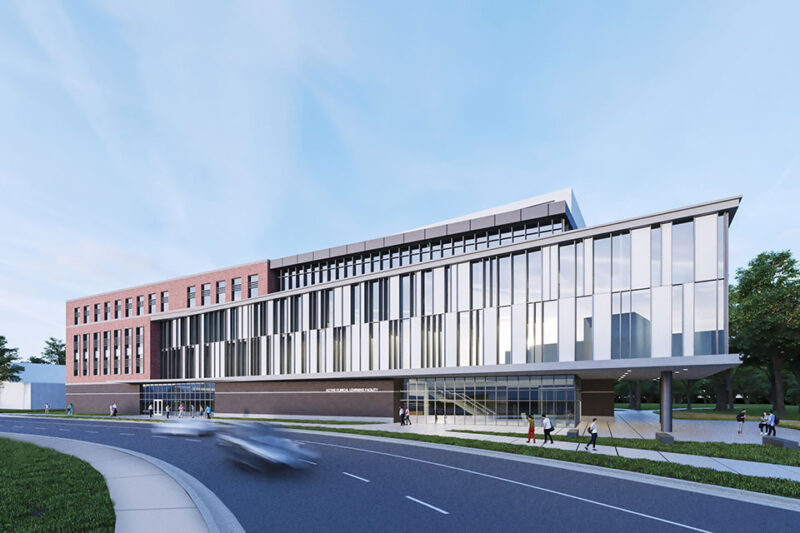New Nursing and Pharmacy Education Building to support hallmarks of Purdue Nursing education through innovation, collaboration
Written By: Rebecca Hoffa, rhoffa@purdue.edu

A conceptual rendering of Purdue’s Nursing and Pharmacy Education Building.(Photo provided)
Purdue University’s colleges of Health and Human Sciences (HHS) and Pharmacy are taking giant leaps in advancing collaborative, innovative learning for health care professionals in Indiana through a new facility at the corner of Mitch Daniels Boulevard and Russell Street.
The Nursing and Pharmacy Education Building, which is projected to be approximately 75,000 assignable square feet, will address the country’s critical workforce needs for skilled nurses and pharmacists and expand interprofessional education opportunities that mirror modern health care settings.
“We are thrilled to see this joint effort between the College of Health and Human Sciences and the College of Pharmacy become a reality,” said Marion K. Underwood, dean of the College of Health and Human Sciences. “Through the building’s highly synergetic design, this new space will allow two of Purdue’s outstanding health care programs to learn alongside each other through valuable interprofessional education and greater research opportunities.”
Libby Richards, associate professor in the School of Nursing, has served as the Nursing faculty representative on the $160 million project alongside university, HHS and Pharmacy leadership, seeing it move from the initial idea to a funded venture. The project received an $89 million appropriation from the Indiana legislature in April in addition to the more than $70 million in private and institutional funding that has been collectively raised by the university, HHS and the College of Pharmacy.
In her leadership role, Richards has been able to talk with key stakeholders and weigh in on architectural decisions to blend together characteristics of the best nursing and pharmacy academic buildings in the country.
“We’ve been very strategic to create a team of experts including simulation education, nursing skills and health assessment, and health-related research to know specifics on what kind of space we need,” Richards said. “It has been fun to work as a team and get buy-in from our faculty, staff and students along the way. Helping to make sure everyone feels a sense of ownership over this building process has been very important.”
The new Nursing and Pharmacy Education Building is proposed to house four floors featuring clinical simulation labs, collaboration spaces, large active-learning classrooms and modern research facilities. The building’s design will encourage nursing and pharmacy faculty and students to collaborate; conduct interdisciplinary research; and develop strategies that make a difference across public health, mental health, health equity and more.
“The new building is a reflection of our outstanding faculty and our highly sought-after graduates,” said Nancy Edwards, professor and interim head of the School of Nursing, “Our graduates are known throughout the United States for their ability to positively impact patient care and the healthcare systems they work in. The quality education and collaboration that are provided at Purdue can only be enhanced by the cutting-edge facilities planned for this new building.”
Richards noted that because careers in nursing and pharmacy are not isolated from each other, it’s important for the students to immerse themselves in interprofessional learning early and often to understand everyone’s role in the health care landscape. The new building will make these learning opportunities possible.
“That link is critical,” Richards said. “The nurses are the ones reviewing orders for medications and administering medications, but pharmacists are the ones preparing medications. When nurses and pharmacists work together, errors can be decreased in terms of the right dose or the right route. It’s important for pharmacists to understand the full scope of nursing practice and for nurses to understand the full scope of pharmacy practice, and unless you are educating these health professions together, you are not going to know that — that’s really the only way.”
Ultimately, Richards said she is most excited for nursing students to have a centrally located academic home, as the program’s faculty, staff and students are currently scattered throughout the West Lafayette campus.
The new building will also afford opportunities to strategically grow the number of nursing students and faculty to maintain the School of Nursing as a leader in shaping health and well-being in Indiana. Currently, 70% of Bachelor of Science in Nursing (BSN) graduates and over 90% of nursing graduate students stay and work in Indiana, having a direct influence on the health of Hoosiers. By being able to provide more space and educational opportunities for students, the building will address existing shortages of nurses and advanced practice providers.
“The School of Nursing is known for outstanding education, but I think the educational opportunities students will have in the new building will be even more impactful,” Richards said. “I think it’s going to further highlight the leadership and preeminence that we have.”
Although the initial funding goal has been met, there’s still more work to be done, as leadership and faculty work to build the inventory of technology and equipment needed to make the space exceptional.
“The space doesn’t matter if you don’t have the right equipment, so that’s where our next priority is — understanding our equipment needs, which range from small things like having TV screens in our debriefing rooms to the simulators, which are significant capital investments,” Richards said. “That’s where our focus is right now.”
Construction of the Nursing and Pharmacy Education Building is estimated to begin in summer 2024 with completion estimated for fall 2026. To learn more about the project, visit the Nursing and Pharmacy Education Building website.